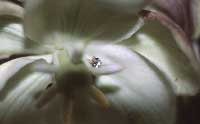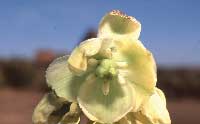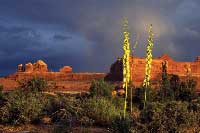Under the cover of darkness, I stalk my quarry. Like ghosts rising up from the desert floor, pale white yucca flowers bloom along elongated stalks. Visible even in the darkness, the cream-colored bulbous flowers open slightly to attract nocturnal pollinators.
I switch on my headlamp and run the beam up and down the stalks. Small, half-inch moths flutter about before landing on the flowers. Crawling along the outside, the moths slip between the overlapping petals and disappear into the flower’s center. These grayish-white moths belong to a group known as Pronuba or Yucca moths; their lives are intertwined with those of the yuccas.
Male and female moths mature at the same time, then mate. Afterwards, the female moth flies to a yucca flower where the insect gathers a small ball of pollen and holds it under its chin. These moths lack long tongues characteristic of most moths and butterflies; instead they have short tentacles around their mouthparts that hold the pollen in place.
After harvesting some pollen, the female flies to another yucca plant and checks to see if a different female has already laid her eggs here. Using her antennae to smell for scent, the female crawls inside the flower and proceeds to the flower’s stigma. The stigma is the “female” receptor of the flower that houses the ovary and where the pollen is deposited. The moth then stuffs the ball of pollen into the stigma, ensuring the cycle of pollination is completed. When this chore is done, the female then deposits her eggs into the base of the ovary. 
As the ovaries develop, the moth’s larvae develop along with the seeds. Consuming some of the seeds during this phase, the larvae will drop out of the forming seedpod and go underground to form a cocoon. The larvae do not eat all the seeds, thus ensuring future generations of yuccas and host plants for the moths.
Though the Native American’s relationship to the yucca was not as mutually beneficial, they did use the plants for food, a fiber source and even shampoo.
In addition to eating young flowers, the yucca seedpods were also harvested and roasted or eaten raw. Sometimes the young flower shoots were collected and eaten like asparagus.
The bayonet-like leaves provided the early inhabitants with a strong fiber which they separated from the leaves by soaking them in water and pounding off the outer covering to access the strands. These were then plaited together and twisted into a strong string that could be woven together to make rope, nets, traps, cloth and even sandals. Petroglyphs along the San Juan River resemble yuccas and highlight the importance of these plants to the Ancient Ones.
In addition to harvesting the leaves for fibers, the native people used the stiff leaves as paintbrushes. Lightly chewing or pounding on the flattened end of the leaf provided various-sized brushes for them to use on their pottery or when painting images on the rocks.
Another by-product of the plant was a shampoo that was made from adding water to pounded roots which are rich in saponins - chemical compounds roots with soap-like qualities. The foamy water was used for ritual cleansing.
Narrowleaf yucca and Spanish bayonet are two common species growing in Canyon Country. Although their beauty can be observed during the day, I think a greater appreciation of the yucca’s flowers is gained during the darkness.



